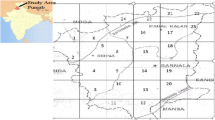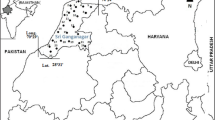Abstract
This study examines 52 water samples from diverse locations in the Dehradun district, measuring radon activity concentrations with a scintillation-based monitor. The findings indicate an average concentration of 33.97 Bq/L, ranging from 3.35 to 99.25 Bq/L. Beyond this, the research estimates annual effective ingestion (µSv/y), inhalation (µSv/y), and total (µSv/y) doses attributed to radon in the drinking water samples, offering insights into potential health risks. Additionally, the study explores spatial patterns in the dataset, providing a geographic perspective on radon distribution across the region. This spatial analysis enhances our understanding of localised exposure risks, contributing valuable information for public health and environmental considerations in the Dehradun district.






Similar content being viewed by others
References
Commission E (2001) Commission recommendation of 20 December 2001 on the protection of the public against exposure to radon in drinking water supplies L344/85. Off J Eur Communit 4:4
Ali SA, Ali U (2018) Hydrochemical characteristics and spatial analysis of groundwater quality in parts of Bundelkhand Massif, India. Appl Water Sci 8:39. https://doi.org/10.1007/s13201-018-0678-x
Verma R, Suthar S (2015) Lead and cadmium removal from water using duckweed—Lemna gibba L.: Impa ct of pH and initial metal load. Alex Eng J 54:1297–1304. https://doi.org/10.1016/j.aej.2015.09.014
Sayato Y (1989) WHO Guidelines for drinking-water quality. Eisei Kagaku 35:307–312. https://doi.org/10.1248/jhs1956.35.307
Kumar A, Singh P, Agarwal T et al (2020) Statistical inferences from measured data on concentrations of naturally occurring radon, thoron, and decay products in Kumaun Himalayan belt. Environ Sci Pollut Res 27:40229–40243. https://doi.org/10.1007/s11356-020-09920-9
Kumar A, Arora T, Singh P et al (2021) Quantification of radiological dose and chemical toxicity due to radon and uranium in drinking water in Bageshwar region of Indian Himalaya. Groundw Sustain Dev 12:100491
Cosma C, Moldovan M, Dicu T, Kovacs T (2008) Radon in water from Transylvania (Romania). Radiat Meas 43:1423–1428. https://doi.org/10.1016/J.RADMEAS.2008.05.001
Nagaraja K, Prasad BSN, Madhava MS et al (2003) Radon and its short-lived progeny: variations near the ground. Radiat Meas 36:413–417
Kumar M, Kaushal A, Sahoo BK et al (2019) Measurement of uranium and radon concentration in drinking water samples and assessment of ingestion dose to local population in Jalandhar district of Punjab, India. Indoor Built Environ 28:611–618
Meisenberg O, Mishra R, Joshi M et al (2017) Radon and thoron inhalation doses in dwellings with earthen architecture: comparison of measurement methods. Sci Total Environ 579:1855–1862
Kaur M, Kumar A, Mehra R, Mishra R (2020) Assessment of radon, thoron, and their progeny concentrations in the dwellings of Shivalik hills of Jammu and Kashmir, India. Environ Geochem Health, 1–17
Mishra R, Sapra BK, Prajith R et al (2015) Inhalation exposures due to radon and thoron (222Rn and 220Rn): Do they differ in high and normal background radiation areas in India? J Environ Radioact 147:125–129
La Verde G, Artiola V, D’Avino V et al (2021) Measurement of natural radionuclides in drinking water and risk assessment in a volcanic region of Italy. Campania Water 13:3271. https://doi.org/10.3390/w13223271
Kumar A, Singh P, Semwal P et al (2021) Study of primordial radionuclides and radon/thoron exhalation rates in Bageshwar region of Kumaun Himalaya, India. J Radioanal Nucl Chem 328:1361–1367
Singh P, Nautiyal OP, Joshi M et al (2021) Assessment of physicochemical and radon-attributable radiological parameters of drinking water samples of Pithoragarh district, Uttarakhand. J Radioanal Nucl Chem. https://doi.org/10.1007/s10967-021-08056-5
Kandari T, Singh P, Semwal P et al (2021) Evaluation of background radiation level and excess lifetime cancer risk in Doon valley, Garhwal Himalaya. J Radioanal Nucl Chem 330:1545–1557
Nautiyal OP, Singh P, Ahamad T (2023) Investigation of 222Rn and 220Rn exhalation rates from soil samples of Pithoragarh District. J Radioanal Nucl Chem, India. https://doi.org/10.1007/s10967-023-09087-w
Mohuba SC, Abiye T, Nhleko S (2022) Evaluation of radionuclide levels in drinking water from communities near active and abandoned gold mines and tailings in the West Rand Region, Gauteng, South Africa. Minerals 12:1370. https://doi.org/10.3390/min12111370
Appleton JD (2013) Radon in air and water. Essentials of medical geology. Springer, pp 239–277
Kumar A, Singh D, Semwal P et al (2022) Comparative study of two different water sources in the aspect of radiological exposure to the local population of Bageshwar, India. J Radioanal Nucl Chem 331:1941–1949
Saini K, Singh P, Singh P et al (2017) Seasonal variability of equilibrium factor and unattached fractions of radon and thoron in different regions of Punjab, India. J Environ Radioact 167:110–116. https://doi.org/10.1016/j.jenvrad.2016.11.022
UNSCEAR (2000) Sources and effects of ionizing radiation. Sources 1
Herschy RW (2012) Water quality for drinking: WHO guidelines. Encycl Earth Sci Ser. https://doi.org/10.1007/978-1-4020-4410-6_184
WHO (2008) Guidelines for drinking-water quality: second addendum, vol 1. World Health Organization, Recommendations
Choubey VM, Bartarya SK, Ramola RC (2000) Radon in Himalayan springs: a geohydrological control. Environ Geol 39:523–530
Valdiya KS (1988) Tectonics and evolution of the central sector of the Himalaya. Philos Trans R Soc London Ser A Math Phys Sci 326:151–175
Patni K, Pande AP, **dal MK, Joshi T (2023) Gamma radiation dose rate in high-altitude areas in the Bageshwar, Champawat and Pithoragarh districts of Uttarakhand, India. Environ Geochem Health 45(11):8119–8133
Gaware JJ, Sahoo BK, Sapra BK, Mayya YS (2011) Indigenous development and networking of online radon monitors in the underground uranium mine. Radiat Prot Environ 34:37
Sowby FD (1981) Annals of the ICRP. Ann ICRP 6:1. https://doi.org/10.1016/0146-6453(81)90127-5
Silva EL, Lisboa P (2007) Analysis of the characteristic features of the density functions for gamma, Weibull and log-normal distributions through RBF network pruning with QLP. In: Proc 6th WSEAS Int 223–228
Leon Harter H, Khamis HJ, Lamb RE (1984) Modified Kolmogorov-Smirnov tests of goodness of fit. Commun Stat Comput 13:293–323
Stephens MA (1978) Goodness of fit tests with special reference to tests for exponentiality. Stanford univ ca dept of statistics. Technical report: ADA060824.
Achilleos GA (2011) The inverse distance weighted interpolation method and error propagation mechanism–creating a DEM from an analogue topographical map. J Spat Sci 56:283–304
Khouni I, Louhichi G, Ghrabi A (2021) Use of GIS based inverse distance weighted interpolation to assess surface water quality: case of Wadi El Bey. Tunis Environ Technol Innov 24:101892
Acknowledgements
The authors extend their gratitude to the Uttarakhand Science Education and Research Centre (USERC), Dehradun, for their invaluable support in facilitating the laboratory infrastructure and essential resources required to conduct the aforementioned experimental research.
Author information
Authors and Affiliations
Corresponding author
Ethics declarations
Conflict of interest
The authors declare that there are no disclosed financial conflicts of interest or personal relationships that could be perceived as having influenced the research presented in this paper.
Additional information
Publisher's Note
Springer Nature remains neutral with regard to jurisdictional claims in published maps and institutional affiliations.
Rights and permissions
Springer Nature or its licensor (e.g. a society or other partner) holds exclusive rights to this article under a publishing agreement with the author(s) or other rightsholder(s); author self-archiving of the accepted manuscript version of this article is solely governed by the terms of such publishing agreement and applicable law.
About this article
Cite this article
Saklani, C.P., Singh, P., Kumar, A. et al. Delineating the radiological dosimetry arising from radon exposure in potable water sources of Dehradun, India. J Radioanal Nucl Chem 333, 3259–3268 (2024). https://doi.org/10.1007/s10967-023-09343-z
Received:
Accepted:
Published:
Issue Date:
DOI: https://doi.org/10.1007/s10967-023-09343-z




